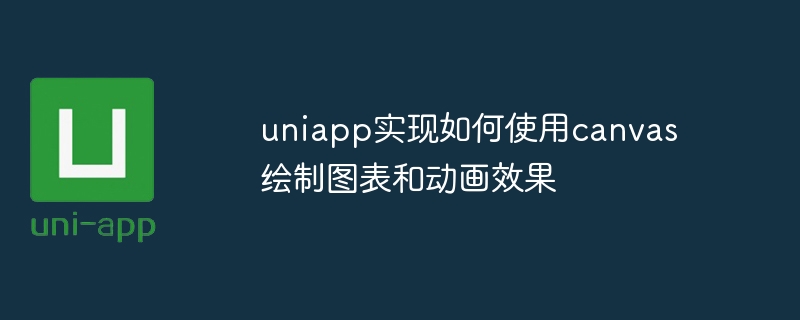

uniapp implements how to use canvas to draw charts and animation effects, requiring specific code examples
1. Introduction
With the popularity of mobile devices, more and more The application needs to display various charts and animation effects on the mobile terminal. As a cross-platform development framework based on Vue.js, uniapp provides the ability to use canvas to draw charts and animation effects. This article will introduce how uniapp uses canvas to achieve chart and animation effects, and give specific code examples.
2. Basic introduction to canvas
Canvas is a new drawing element in HTML5. It can be used to draw graphics, create animations, and even perform data visualization. When using canvas, we can control the drawn content through JavaScript to achieve various complex effects.
3. Using canvas in uniapp
When using canvas in uniapp, you generally need to pay attention to the following steps:
The following is a code example for drawing a histogram in uniapp using canvas:
<template>
<view>
<canvas canvas-id="chart" style="width:100%;height:200px;"></canvas>
</view>
</template>
<script>
export default {
onReady() {
const chartCtx = uni.createCanvasContext('chart', this);
const data = [80, 120, 200, 150, 300];
const barWidth = 30;
const chartHeight = 150;
const chartWidth = barWidth * data.length;
// 绘制坐标轴
chartCtx.setStrokeStyle("#333");
chartCtx.moveTo(10, 10);
chartCtx.lineTo(10, chartHeight + 10);
chartCtx.lineTo(chartWidth + 10, chartHeight + 10);
chartCtx.stroke();
// 绘制柱状图
data.forEach((value, index) => {
const startX = (index + 1) * (barWidth + 10);
const startY = chartHeight - value + 10;
chartCtx.setFillStyle("#66ccff");
chartCtx.fillRect(startX, startY, barWidth, value);
});
chartCtx.draw();
}
}
</script>In the above example, by getting the canvas's drawing context object chartCtx, we can use the object Various APIs to achieve the effect of drawing charts. First, we draw the coordinate axis, and then draw multiple rectangles through a loop to achieve the effect of a histogram. Finally, the drawn content is displayed on the canvas by calling chartCtx.draw().
4. Canvas animation effects
In addition to drawing charts, we can also use the canvas in uniapp to create various animation effects. The following is a code example that uses canvas to achieve a simple animation effect:
<template>
<view>
<canvas canvas-id="animation" style="width:200px;height:200px;"></canvas>
</view>
</template>
<script>
export default {
onReady() {
const animationCtx = uni.createCanvasContext('animation', this);
let angle = 0;
setInterval(() => {
animationCtx.clearRect(0, 0, 200, 200);
animationCtx.beginPath();
animationCtx.arc(100, 100, 50, 0, 2 * Math.PI);
animationCtx.setFillStyle("#66ccff");
animationCtx.fill();
animationCtx.closePath();
animationCtx.beginPath();
animationCtx.arc(100, 100, 50, 0, angle);
animationCtx.setStrokeStyle("#ffcc00");
animationCtx.setLineWidth(5);
animationCtx.stroke();
animationCtx.closePath();
animationCtx.draw();
angle += 0.1;
if (angle >= 2 * Math.PI) {
angle = 0;
}
}, 50);
}
}
</script>In the above example, we set a timer to continuously clear the canvas and draw an arc to achieve a simple animation effect. Using timers, we can modify various attributes according to our own needs to achieve more complex animation effects.
Summary:
This article introduces the basic method of using canvas to draw charts and animation effects in uniapp through specific code examples. Through the canvas drawing context object, we can achieve the required effects by calling various APIs. I hope this article will be helpful to you in charting and animation effects in uniapp development.
The above is the detailed content of uniapp implements how to use canvas to draw charts and animation effects. For more information, please follow other related articles on the PHP Chinese website!




